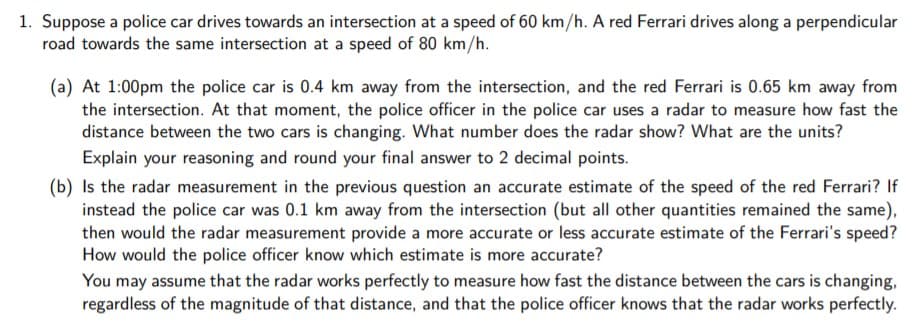. Suppose a police car drives towards an intersection at a speed of 60 km/h. A red Ferrari drives along a perpendicular road towards the same intersection at a speed of 80 km/h. (a) At 1:00pm the police car is 0.4 km away from the intersection, and the red Ferrari is 0.65 km away from the intersection. At that moment, the police officer in the police car uses a radar to measure how fast the distance between the two cars is changing. What number does the radar show? What are the units? Explain your reasoning and round your final answer to 2 decimal points. (b) Is the radar measurement in the previous question an accurate estimate of the speed of the red Ferrari? If instead the police car was 0.1 km away from the intersection (but all other quantities remained the same), then would the radar measurement provide a more accurate or less accurate estimate of the Ferrari's speed? How would the police officer know which estimate is more accurate? You may assume that the radar works perfectly to measure how fast the distance between the cars is changing, regardless of the magnitude of that distance, and that the police officer knows that the radar works perfectly.
. Suppose a police car drives towards an intersection at a speed of 60 km/h. A red Ferrari drives along a perpendicular road towards the same intersection at a speed of 80 km/h. (a) At 1:00pm the police car is 0.4 km away from the intersection, and the red Ferrari is 0.65 km away from the intersection. At that moment, the police officer in the police car uses a radar to measure how fast the distance between the two cars is changing. What number does the radar show? What are the units? Explain your reasoning and round your final answer to 2 decimal points. (b) Is the radar measurement in the previous question an accurate estimate of the speed of the red Ferrari? If instead the police car was 0.1 km away from the intersection (but all other quantities remained the same), then would the radar measurement provide a more accurate or less accurate estimate of the Ferrari's speed? How would the police officer know which estimate is more accurate? You may assume that the radar works perfectly to measure how fast the distance between the cars is changing, regardless of the magnitude of that distance, and that the police officer knows that the radar works perfectly.
Algebra & Trigonometry with Analytic Geometry
13th Edition
ISBN:9781133382119
Author:Swokowski
Publisher:Swokowski
Chapter7: Analytic Trigonometry
Section7.6: The Inverse Trigonometric Functions
Problem 91E
Related questions
Question
100%
q1

Transcribed Image Text:1. Suppose a police car drives towards an intersection at a speed of 60 km/h. A red Ferrari drives along a perpendicular
road towards the same intersection at a speed of 80 km/h.
(a) At 1:00pm the police car is 0.4 km away from the intersection, and the red Ferrari is 0.65 km away from
the intersection. At that moment, the police officer in the police car uses a radar to measure how fast the
distance between the two cars is changing. What number does the radar show? What are the units?
Explain your reasoning and round your final answer to 2 decimal points.
(b) Is the radar measurement in the previous question an accurate estimate of the speed of the red Ferrari? If
instead the police car was 0.1 km away from the intersection (but all other quantities remained the same),
then would the radar measurement provide a more accurate or less accurate estimate of the Ferrari's speed?
How would the police officer know which estimate is more accurate?
You may assume that the radar works perfectly to measure how fast the distance between the cars is changing,
regardless of the magnitude of that distance, and that the police officer knows that the radar works perfectly.
Expert Solution
This question has been solved!
Explore an expertly crafted, step-by-step solution for a thorough understanding of key concepts.
Step by step
Solved in 2 steps with 2 images

Recommended textbooks for you

Algebra & Trigonometry with Analytic Geometry
Algebra
ISBN:
9781133382119
Author:
Swokowski
Publisher:
Cengage

Algebra & Trigonometry with Analytic Geometry
Algebra
ISBN:
9781133382119
Author:
Swokowski
Publisher:
Cengage